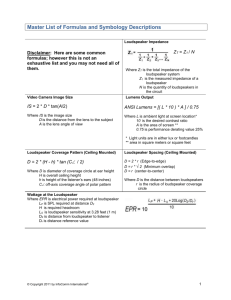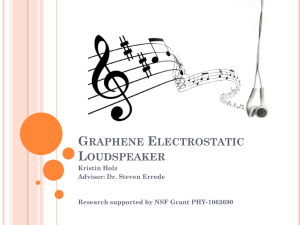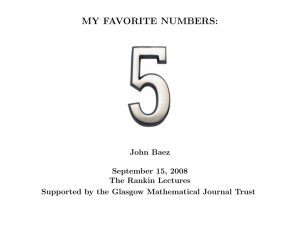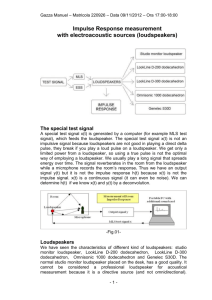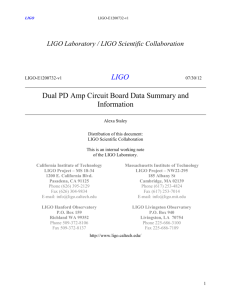PowerPoint - Spherovox
advertisement
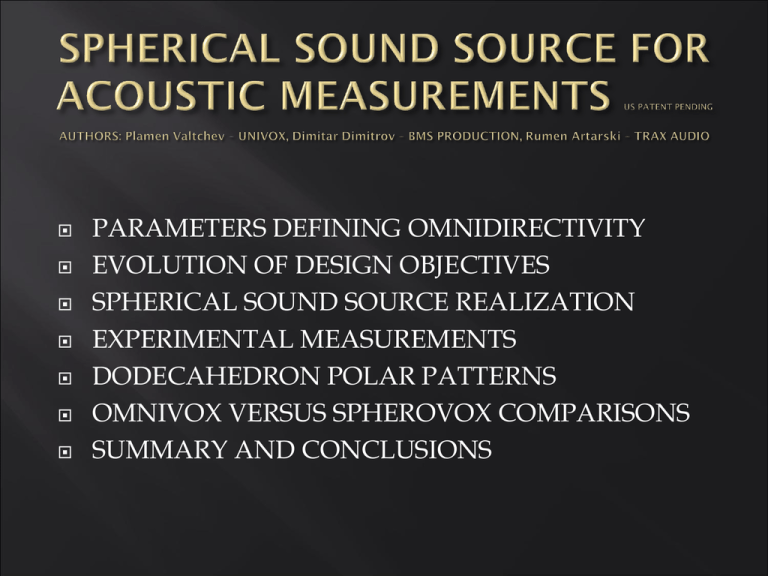
PARAMETERS DEFINING OMNIDIRECTIVITY EVOLUTION OF DESIGN OBJECTIVES SPHERICAL SOUND SOURCE REALIZATION EXPERIMENTAL MEASUREMENTS DODECAHEDRON POLAR PATTERNS OMNIVOX VERSUS SPHEROVOX COMPARISONS SUMMARY AND CONCLUSIONS Omni is a Latin prefix meaning "all" or "every“ DIRECTIONS – BUT HOW MANY - 4, 5, 6, 12, 20, 120 or MORE –inf ISO-3382 – AS OMNI DIRECTIONAL AS POSSIBLE MONOHEDRON DIHEDRON TRIHEDRON TETRAHEDRON HEXAHEDRON – CUBE OCTAHEDRON DODECAHEDRON ICOSAHEDRON LETS OPEN THE FACE (HEDRA) – AND THINK OF IT AS BEENG MOUTH OF A HORN WITH ITS DRIVER INTO THE CENTER OF THE POLYHEDRON ICOSA-HORN DODECA-HORN OCTA-HORN HEXA-HORN (6 HORNS ON 6 SURFACES OF A CUBE) PENTA-HORN TETRA-HORN TRI-HORN DI-HORN MONO-HORN BY REDUCING THE HORN NUMBER, INTERFERENCE ZONES ARE REDUCED THE LOWER THE NUMBER, THE LESS IS INTERFERENCE BY MATCHING -6dB POLAR PATTERN HORN ANGLE WITH SOLID SPHERICAL POLI-ANGLE, INTERFERENCES COULD BE MINIMIZED THE LONG WAY FROM PENTAHORN-THRU TRIHORN TO MONOHORN Three 100x100 deg Horns 120 deg apart, forming the cylindrical surface Two Conical Horns at the end of a Cylinder 5 Compression Drivers – 3 Horizontally radiated and 2 vertically (up/down) Two 15” Coaxial Loudspeaker at the end of a Cylinder Three 100x100 deg JBL 2344A Horns 120 deg apart, forming the cylindrical surface Two Bass reflex openings WEAKNESSES ON-AXIS (ROOM) INTERFERENCES HARDLY POSSIBLE FOR 2344A TO GO BELOW 630 Hz LACK OF FULL ROTATIONAL SYMMETRY (3-fold Symmetry Only Available) FROM PENTA-HORN TO MONO-HORN / SPHEROVOX MAIN FITURES 3 PAIRS OF DIPOLES IN MONOPOLE CONFIGURATIONS EVERY LOUDSPEAKER COMPONENT HAS ROTATIONAL SYMETRY ALL LOUDSPEAKER COMPONENTS SHARE THE SAME (VERTICAL) AXIS THE TWO LOUDSPEAKERS IN EACH PAIR ARE AS CLOSELLY MOUNTED ONE TO THE OTHER AS POSSIBLE VIRTUAL POINT SOUND SOURCE To HF Co-AXIALS 2–10 kHz INPUT DELAY-H HIGH/250W AXIS of ROT. SYMMETRY X-OVER DSP/EQ 500Hz–10kHz H L MID-HIGH/250W 50–500 Hz DELAY- L LOW/1200W To LF Co-AXIALS MEASURING SIGNAL – FREQUENCY MODULATED SINEWAVE WITHIN 1/3oct DR. BENJAMIN BERNFELD CD UNDER PIERRE VERANY LABEL -1984 400Hz,500Hz,630Hz 1/3 Oct FM-PN 500Hz 1/1 Oct FM-PN – MIXING 400,500,630Hz 1/3 MEASURING ROOM – SEMI ANEQOICK CHAMBER 150m3 PINK NOISE VS FM-SINE WAVE EQUIVALENT SIGNAL ADVANTAGES FAST MEASUREMENT TIME EXITE ALL ROOM MODES WITHIN THE BAND DON’T NEED HUGE POWER AMP TO CARY PEEKS HIGHER DYNAMICS OF MEASUREMENTS VERY PRECISE FOR TURN TABLE MEASUREMENT AT LOW FREQUENCY ADVISABLE FOR ANY ACOUSTIC MEASUREMENT AS PINK NOISE ALTERNATIVE 125 Hz (OUTERMOST) 250 Hz 500 Hz 1kHz (INNERMOST) 2kHz oct (outermost)–1.6k/2k/2.5k, 1/3oct-RGB HF Co-Axial Drivers Switched off VERTICAL HORIZONTAL ALL HORIZONTAL POLAR PATTERNS ARE IDEAL CIRCLES FOR ALL FREQUENCY, AT ANY FREQUENCY BAND – 1/1oct, 1/3oct, PURE SINE WAVE 4kHz oct (outermost)–3.2k/4k/5k, 1/3oct-RGB HF Co-Axial Drivers Switched off There are an infinite number of different polar pattern planes of measurement across the dodecahedron center Four axes, however, determine particular dodecahedron symmetry These two planes of measurement don’t coincide with any loudspeaker axis There are 10 such 3-fold symmetry axis There are 6 such 5-fold symmetry axis This first “vertical” plane of measurement crosses 4 LS acoustic centers This second “eccentric” axis uses plane of measurement trough 2 LS acoustic centers These two planes of measurement share common mic axes equally distant to 2 pairs of LS at a time, and another ones equally distant to 5 LS centers There are 15 such 2-fold symmetry axis There are 30 such axis LOW FREQUENCY LOUDSPEAKERS–RED CURVES HIGH FREQUENCY COMPRESSION DRIVERS – BLUE CURVES 2kHz oct (outermost)–1.6k/2k/2.5k 1/3oct-RGB 4kHz oct (outermost)–3.2k/4k/5k 1/3oct-RGB MEASURING IN A PLANE, IN WHICH NO LOUDSPEAKER AXIS LIE – SO CALLED “HORIZONTAL PLAIN” GIVEN IS SOUND POWER LEVEL FREQUENCY RESPONSE INSTEAD OF POLAR PATERN SMOOTHING ANGULAR RESOLUTION, AS DONE IN ISO3382 PAPER STANDARD BY “GLIDING” CONCEPT – PRESENTING SO CALLED “DEVIATION FROM OMNIDIRECTIVITY” GIVING MISLEADINGLY GENUINE SPHERICAL SHAPE – EVEN WITH SPHERICAL PROTECTING GRILS SPHEROVOX - 2kHz OMNIVOX – 2kHz SPHEROVOX - 4kHz OMNIVOX – 4kHz SPHEROVOX - 4kHz Coaxial Drivers Switched off OMNIVOX – 4kHz SPHEROVOX - 4kHz Coaxial Drivers Switched off OMNIVOX – 4kHz Free Field Directional SPL Differences - dB SPL Frequency Response at 3 random, 15deg apart, off-Axis Steps – 2m Mic Distance Spherovox – Verical 15deg Steps Omnivox – Horizontal Plane 15deg Steps Two 15” Coaxial Loudspeaker Double Dual Diaphragm Large Format CD MonoHorn US Patent 5,878,148 – 1997 Inventor – D.Dimitrov ADVANTAGES REDUSED HORN CUT-OFF FREQUENCY WITH THE SAME EXTENTION RATE CROSSOVER FREQUENCY DOWN TO - 250 Hz THD PERFORMANCE АТ 125dB/1m <-40dB (2nd),<-50(3th) – 50Hz-10kHz It is impractical to have HR dodecahedron 3-D polar pattern measured . Maximum directional SPL deviation in any band however could easily be evaluated by a single polar pattern in a plane, determined by at least two loudspeaker axes. 30 dB L/R 1/3 octave band maximum SPL variation values, and about 20 dB octave ones for 2kHz to 4kHz bands could be expected in rooms with dodecahedron measurements in horizontal plane. Spherovox will give 2-3dB maximum L/R variations under the same conditions, which is 10 times better. Spherovox has about 10 dB higher SPL sensitivity and about 10db higher Power handling capabilities than marketed Dodecahedrons – meaning about 20 dB higher SWL Capabilities. Spherovox exhibit perfectly circled horizontal polar patterns for all frequency 50Hz-10kHz, and for all frequency bans including pure sine wave, and “3 or 5 equally rotational steps” during measurements are misconception. Some spatial parameters measured with dodecahedrons are hardly usable after “3 or 5 equally rotational steps” averages. Both Omnivox and Spherovox are fully ISO3382 compliant , which is deeply erroneous. [1] Hak, Wenmaekers, Hak, van Luxemburg - The Source Directivity of a Dodecahedron Sound Source determined by Stepwise Rotation, FORUM ACUSTICUM 2011/27. June - 1. July, Aalborg, Denmark. [2] ISO 3382-1 International Standard ISO/DIS 3382-1: Acoustics Measurement of room acoustic parameters–Part1:Performance rooms. International Organization for Standardization, 2009. [3] Angelo Farina, Advancements in impulse response measurements by sine sweeps, Presented at the 122nd AES Convention 2007 May 5– 8 Vienna, Austria. [4] Leo L.Beranek, Acoustics pp103,104. [5] T. W. Leishman, S. Rollins, and H. M. Smith, “An experimental evaluation of regular polyhedron loudspeakers as omnidirectional sources of sound,” J. Acoust. Soc. Am. 120, 1411–1422 (2006). Plamen Valtchev – plamen@spherovox.com Dimitar Dimitrov – dimo@spherovox.com Rumen Artarski – rumen@spherovox.com www.spherovox.com


